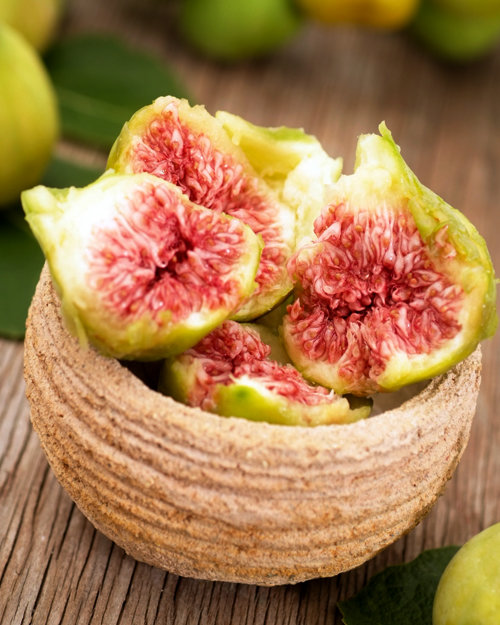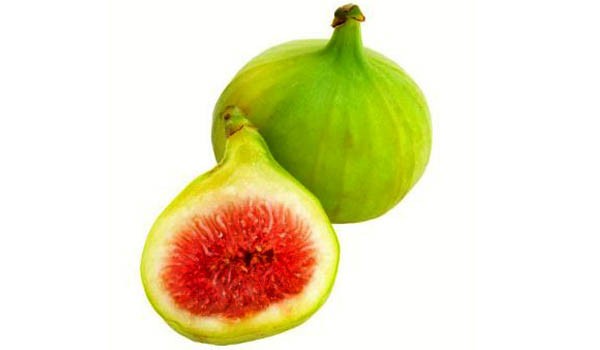- Overview
Common name: Fig Botanical name: Ficus carica Family: Moraceae Origin: Western Asia Avg. Height: 10-30 Feet Fig Tree Ischia Green Variety in a 3 Gallon Container. With a history that dates back to 5,000 B.C. the edible fig is one of the most widely recognized and distributed fruits in the world. They were first introduced to the New World through Mexico in 1560 and then to California in 1769. It is one of the few fruits that can be grown in all fifty states, and there are a multitude of varieties suitable to each growing region. The Black Mission and especially the Brown Turkey variety are the two best for tropical and subtropical climates. Black Mission figs are teardrop in shape with thin black skin and a reddish flesh. Sweeter than honey these larger figs are the cream of the crop. They provide 2 crops a year.
Description
Origin and Distribution
Climate
Soil
Propagation
Culture
Season
Harvesting And Yield
Keeping Quality
Pests and Diseases
Food Uses
Toxicity
Other Uses
Medicinal Uses
Food ValueWhile the ancient history of the fig centers around the Mediterranean region, and it is most commonly cultivated in mild-temperate climates, it nevertheless has its place in tropical and subtropical horticulture. Botanically identified as Ficus carica L. (family Moraceae), it is unique in a genus embracing perhaps over 1,000 species, mostly giant "rubber trees", and mostly tropical. It is almost universally known simply as fig, common fig, or edible fig. The name is very similar in French (figue), German (feige), Italian and Portuguese (figo). In Spanish it is higo or brevo. Haitians give it the name, figue France, to distinguish it from the small, dried bananas called "figs".
Description
The fig is a tree of small dimensions, 10 to 30 ft (3-9 m) high, with numerous spreading branches and a trunk rarely more than 7 in (17.5 cm) in diameter. It contains copious milky latex. The root system is typically shallow and spreading, sometimes covering 50 ft (15 m) of ground, but in permeable soil some of the roots may descend to 20 ft (6 m). The deciduous leaves are palmate, deeply divided into 3 to 7 main lobes, these more shallowly lobed and irregularly toothed on the margins. The blade is up to 10 in (25 cm) in length and width, fairly thick, rough on the upper surface, softly hairy on the underside. What is commonly accepted as a "fruit" is technically a synconium, that is, a fleshy, hollow receptacle with a small opening at the apex partly closed by small scales. It may be obovoid, turbinate, or pear-shaped, 1 to 4 in (2.5-10 cm) long, and varies in color from yellowish-green to coppery, bronze, or dark-purple. Tiny flowers are massed on the inside wall. In the case of the common fig discussed here, the flowers are all female and need no pollination. There are 3 other types, the ''Caprifig'' which has male and female flowers requiring visits by a tiny wasp, Blastophaga grossorum; the "Smyrna" fig, needing crosspollination by Caprifigs in order to develop normally; and the "San Pedro" fig which is intermediate, its first crop independent like the common fig, its second crop dependent on pollination. The skin of the fig is thin and tender, the fleshy wall is whitish, pale-yellow, or amber, or more or less pink, rose, red or purple; juicy and sweet when ripe, gummy with latex when unripe. Seeds may be large, medium, small or minute and range in number from 30 to 1,600 per fruit.
Origin and Distribution
The fig is believed to be indigenous to Western Asia and to have been distributed by man throughout the Mediterranean area. It has been cultivated for thousands of years, remnants of figs having been found in excavations of Neolithic sites traced to at least 5,000 B.C. As time went on, the fig-growing territory stretched from Afghanistan to southern Germany and the Canary Islands. Pliny was aware of 29 types. Figs were introduced into England some time between 1525 and 1548. It is not clear when the common fig entered China but by 1550 it was reliably reported to be in Chinese gardens. European types were taken to China, Japan, India, South Africa and Australia. The first figs in the New World were planted in Mexico in 1560. Figs were introduced into California when the San Diego Mission was established in 1769. Later, many special varieties were received from Europe and the eastern United States where the fig reached Virginia in 1669. The Smyrna fig was brought to California in 1881-82 but it was not until 1900 that the wasp was introduced to serve as the pollinating agent and make commercial fig culture possible. From Virginia, fig culture spread to the Carolinas, Georgia, Florida, Alabama, Mississippi, Louisiana and Texas. The tree was planted in Bermuda in early times and was common around Bahamian plantations in Colonial days. It became a familiar dooryard plant in the West Indies, and at medium and low altitudes in Central America and northern South America. There are fair-sized plantations on mountainsides of Honduras and at low elevations on the Pacific side of Costa Rica. From Florida to northern South America and in India only the common fig is grown. Chile and Argentina grow the types suited to cooler zones. In Venezuela, the fig is one of the fruits in greatest demand by fruit processors. Because of the inadequate supply, a program was launched in 1960 to encourage commercial plantings. In 1976, fresh figs were regarded as highly desirable luxuries and were selling for $6.35 to $7.25 per lb ($14-$16/kg) in Colombia. The Instituto Colombiano Agropecuario had realized some years earlier that fig growing should be encouraged and had established an experimental plantation in 1973. The results were so favorable that they circulated an advisory bulletin to farmers in 1977, including improved methods of cultivation, costs of production and potential revenue.
Climate
In southern India, 'Marseilles' flourishes on hills above 5,000 ft (1,525 m). In tropical areas generally, figs thrive between 2,600 and 5,900 ft (800-1,800 m). The tree can tolerate 10° to 20° of frost in favorable sites. It should have a dry climate with light early spring rains if it is intended for the production of fresh fruit. Rains during fruit development and ripening are detrimental to the crop, causing the fruits to split. The semi arid tropical and subtropical regions of the world are ideal for fig-growing if means of irrigation are available. But very hot, dry spells will cause fruit-drop even if the trees are irrigated.
Soil
The fig can be grown on a wide range of soils; light sand, rich loam, heavy clay or limestone, providing there is sufficient depth and food drainage. Sandy soil that is medium-dry and contains a good deal of lime is preferred when the crop is intended for drying. Highly acid soils are unsuitable. The pH should be between 6.0 and 6.5. The tree is fairly tolerant of moderate salinity.
Propagation
Fig trees have been raised from seed, even seed extracted from commercial dried fruits. Ground- or air-layering can be done satisfactorily, and rapid mass multiplication by tissue culture has been achieved in Greece, but the tree is commonly propagated by cuttings of mature wood 2 to 3 years of age, 1/2 to 3/4 in (1.25-2 cm) thick and 8 to 12 in (20-30 cm) long. Planting must be done within 24 hours but, first, the upper, slanting end of the cutting should be treated with a sealant to protect it from disease, and the lower, flat, end with a root-promoting hormone. Trees of unsatisfactory varieties can be topworked by shield- or patch-budding, or cleft- or bark-grafting.
Culture
Cuttings are raised in nursery beds and are set out in the field after 12 or 15 months. They may be spaced from 6 to 25 ft (1.8-7.5 m) apart depending on the cultivar and the fertility of the soil. A spacing of 13 x 13 ft (4x4 m) allows 260 trees/acre (625 trees/ha). In Colombia, growers are advised to set the trees at 10 x 10 ft (3x3 m) on level land, 10 x 13 ft (3x4 m) on slopes. Fruiting will commence in less than a year from planting out. Young plants will benefit from shading with palm fronds or other material until they are well established. A fertilizer formula of 10-30-10 or 10-20-20 NPK is recommended 2 oz (about 60 g) each for young plants and 1/5 lb (100 g) each for adults, plus minor elements at the rate of 1 oz (30 g) per tree every 6 months. Fig trees are cut back severely in fall or winter, depending on whether the crop is desired the following summer or fall. Branches are often notched to induce lateral branching and increase the yield. If there are heavy rains, drainage ditches should be dug to prevent water-logging. Fig trees remain productive up to 12 or 15 years of age and thereafter the crop declines though the trees may live to a very advanced age.
Season
Fig trees usually bear 2 crops a year, the early season ("breba") fruits being inferior and frequently too acid, and only those of the second, or main, crop of actual value. In Colombia and Venezuela, some fruits are borne throughout the year but there are 2 principal crops, one in May and June and the other in December and January. Large-scale fig producers in California spray ethephon to speed up ripening and then wind-machines are drawn past the trees or helicopter overflights are made to hasten fruit drop, thus shortening the harvest period by as much as 10 days in order to avoid impending rain and insect attack. Proper timing of the growth regulator is crucial to fruit quality.
Harvesting And Yield
The fruits may be picked from the tree or gathered normally or by mechanical sweepers after they fall to the ground. 'Brunswick' is so tender it must be picked when slightly unripe in order to be firm enough for processing. Workers must wear gloves and protective clothing because of the latex. Harvested fruits are spread out in the shade for a day so that the latex will dry a little. Then they are transported to processing plants in wooden boxes holding 22 to 33 lbs (10-15 kg). In India, a fig tree bears 180 to 360 fruits per year. Venezuelan growers expect 132 to 176 lbs (6-8 kg) per tree.
Keeping Quality
Fresh figs are very perishable. At 40° to 43°F (4.44°-6.11°C) and 75% relative humidity, figs remain in good condition for 8 days but have a shelf life of only 1 to 2 days when removed from storage. At 50°F (10°C) and relative humidity of 85%, figs can be kept no longer than 21 days. They remain in good condition for 30 days when stored at 32° to 35° F (0°-1.67° C). If frozen whole, they can be maintained for several months.
Pests and Diseases
Fig trees are prone to attack by nematodes (especially Meloidogyne spp.) and, in the tropics, have been traditionally planted close to a wall or building so that the roots can go underneath and escape damage. A heavy mulch will serve equally well. Today, control is possible with proper application of nematicides. In India, a stem-borer, Batocera rufomaculata, feeds on the branches and may kill the tree. Lepidopterous pests in Venezuela include the fig borer, Azochis gripusalis, the larvae of which feed on the new growth, tunnel down through the trees to the roots and kill the tree. Another, called cachudo de la higuera, has prominently horned larvae up to 3 1/8 in (8 cm) long that can destroy a fig tree in a few days. There are also coleopterous insects of the genera Epitrix and Colaspis that perforate and severely damage the leaves and shoots. Scale insects include Asterolecanium sp. which attacks the bark of trees weakened by excessive humidity or prolonged drought, and the lesser enemy, Saissetia haemispherica. A common and widespread problem is leaf rust caused by Cerotelium fici; bringing about premature leaf fall and reducing yields. It is most prevalent in rainy seasons. Leaf spot results from infection by Cylindrocladium scoparium or Cercospora fici. Fig mosaic is caused by a virus and is incurable. Affected trees must be destroyed. The dried fruit beetle, or sour bug, Carpophilus spp., enters the fruit through the eye and leads to souring and smut caused by Aspergillus niger. This fungus may attack ripening fruits.
Food Uses
Some people peel the skin back from the stem end to expose the flesh for eating out of-hand. The more fastidious eater holds the fruit by the stem end, cuts the fruit into quarters from the apex, spreads the sections apart and lifts the flesh from the skin with a knife blade, discarding the stem and skin. Commercially, figs are peeled by immersion for 1 minute in boiling lye water or a boiling solution of sodium bicarbonate. In warm, humid climates, figs are generally eaten fresh and raw without peeling, and they are often served with cream and sugar. Peeled or unpeeled, the fruits may be merely stewed or cooked in various ways, as in pies, puddings, cakes, bread or other bakery products, or added to ice cream mix. Home owners preserve the whole fruits in sugar sirup or prepare them as jam, marmalade, or paste. Fig paste (with added wheat and corn flour, whey, sirup, oils and other ingredients) forms the filling for the well known bakery product, "Fig Newton". The fruits are sometimes candied whole commercially. In Europe; western Asia, northern Africa and California, commercial canning and drying of figs are industries of great importance. Some drying is done in Poona, India, and there is currently interest in solar-drying in Guatemala. Usually, the fruits are allowed to fully ripen and partially dehydrate on the tree, then are exposed to sulphur fumes for about a half hour, placed out in the sun and turned daily to achieve uniform drying, and pressed flat during the 5- to 7-day process. 'Black Mission' and 'Kadota' figs are suitable for freezing whole in sirup, or sliced and layered with sugar. Dried cull figs have been roasted and ground as a coffee substitute. In Mediterranean countries, low-grade figs are converted into alcohol. An alcoholic extract of dried figs has been used as a flavoring for liqueurs and tobacco.
Toxicity
The latex of the unripe fruits and of any part of the tree may be severely irritating to the skin if not removed promptly. It is an occupational hazard not only to fig harvesters and packers but also to workers in food industries, and to those who employ the latex to treat skin diseases.
Other Uses
Seed oil: Dried seeds contain 30% of a fixed oil containing the fatty acids: oleic, 18.99%; linoleic, 33.72%; linolenic, 32.95%; palmitic, 5.23%; stearic, 2.1 8%; arachidic, 1.05%. It is an edible oil and can be used as a lubricant.
Leaves: Fig leaves are used for fodder in India. They are plucked after the fruit harvest. Analyses show: moisture, 67.6%; protein, 4.3%; fat, 1.7%; crude fiber, 4.7%; ash, 5.3%; N-free extract, 16.4%; pentosans, 3.6%; carotene on a dry weight basis, 0.002%. Also present are bergaptene, stigmasterol, sitosterol, and tyrosine. In southern France, there is some use of fig leaves as a source of perfume material called "fig-leaf absolute"—a dark-green to brownish-green, semi-solid mass or thick liquid of herbaceous-woody-mossy odor, employed in creating woodland scents.
Latex: The latex contains caoutchouc (2.4%), resin, albumin, cerin, sugar and malic acid, rennin, proteolytic enzymes, diastase, esterase, lipase, catalase, and peroxidase. It is collected at its peak of activity in early morning, dried and powdered for use in coagulating milk to make cheese and junket. From it can be isolated the protein-digesting enzyme ficin which is used for tenderizing meat, rendering fat, and clarifying beverages. In tropical America, the latex is often used for washing dishes, pots and pans. It was an ingredient in some of the early commercial detergents for household use but was abandoned after many reports of irritated
or inflamed hands in housewives.
Medicinal_Uses
The latex is widely applied on warts, skin ulcers and sores, and taken as a purgative and vermifuge, but with considerable risk. In Latin America, figs are much employed as folk remedies. A decoction of the fruits is gargled to relieve sore throat; figs boiled in milk are repeatedly packed against swollen gums; the fruits are much used as poultices on tumors and other abnormal growths. The leaf decoction is taken as a remedy for diabetes and calcifications in the kidneys and liver. Fresh and dried figs have long been appreciated for their laxative action.
Food Value Per 100 g of Edible Portion (Flesh)*
Calories 80
Moisture 77.5-86.8g
Protein 1.2-1.3g
Fat 0.14-0.30g
Carbohydrates 17.1-20.3g
Fiber 1.2-2.2 g
Ash 0.48 0.85 g
Calcium 35-78.2 mg
Phosphorus 22-32.9 mg
Iron 0.6-4.09 mg
Sodium 2.0 mg
Potassium 194 mg
Carotene 0.013-0.195 mg
Vitamin A 20-270 I.U.
Thiamine 0.034-0.06 mg
Riboflavin 0.053-0.079 mg
Niacin 0.32-0.412 mg
Ascorbic Acid 12.2-17.6 mg
Citric Acid 0.10-0.44 mg
Note: There are small amounts of malic, boric and oxalic acids.
*According to analyses made in India, Hawaii, Central America, and by the U.S. Department of Agriculture in Washington, D.C - Features
weight: 9.99 lbs : - Reviews1






One of the best gifts I’ve ever given this year! This tree arrived to days before it’s arrival date and looks super healthy and cute wrapped with a pink bow. I would definitely use this company again.